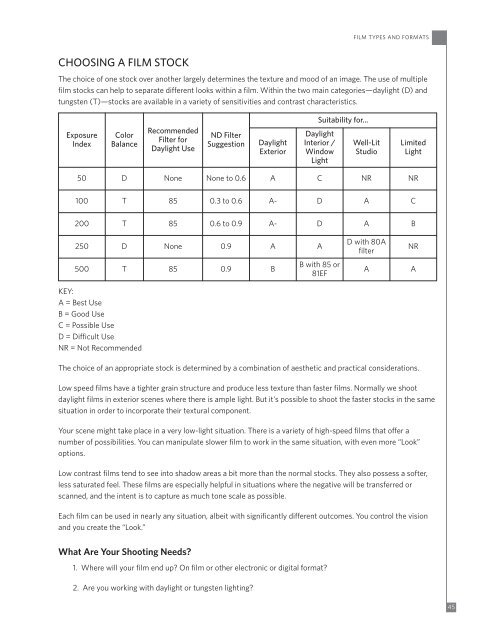You also want an ePaper? Increase the reach of your titles
YUMPU automatically turns print PDFs into web optimized ePapers that Google loves.
CHOOSING A <strong>FILM</strong> STOCK<br />
The choice of one stock over another largely determines the texture and mood of an image. The use of multiple<br />
film stocks can help to separate dierent looks within a film. Within the two main categories—daylight (D) and<br />
tungsten (T)—stocks are available in a variety of sensitivities and contrast characteristics.<br />
Exposure<br />
Index<br />
Color<br />
Balance<br />
KEY:<br />
A = Best Use<br />
B = Good Use<br />
C = Possible Use<br />
D = Dicult Use<br />
NR = Not Recommended<br />
Recommended<br />
Filter for<br />
Daylight Use<br />
The choice of an appropriate stock is determined by a combination of aesthetic and practical considerations.<br />
Low speed films have a tighter grain structure and produce less texture than faster films. Normally we shoot<br />
daylight films in exterior scenes where there is ample light. But it's possible to shoot the faster stocks in the same<br />
situation in order to incorporate their textural component.<br />
Your scene might take place in a very low-light situation. There is a variety of high-speed films that oer a<br />
number of possibilities. You can manipulate slower film to work in the same situation, with even more “Look”<br />
options.<br />
Low contrast films tend to see into shadow areas a bit more than the normal stocks. They also possess a softer,<br />
less saturated feel. These films are especially helpful in situations where the negative will be transferred or<br />
scanned, and the intent is to capture as much tone scale as possible.<br />
Each film can be used in nearly any situation, albeit with significantly dierent outcomes. You control the vision<br />
and you create the “Look.”<br />
What Are Your Shooting Needs?<br />
ND Filter<br />
Suggestion<br />
1. Where will your film end up? On film or other electronic or digital format?<br />
2. Are you working with daylight or tungsten lighting?<br />
Daylight<br />
Exterior<br />
Suitability for...<br />
Daylight<br />
Interior /<br />
Window<br />
Light<br />
<strong>FILM</strong> <strong>TYPES</strong> <strong>AND</strong> <strong>FORMATS</strong><br />
Well-Lit<br />
Studio<br />
Limited<br />
Light<br />
50 D None None to 0.6 A C NR NR<br />
100 T 85 0.3 to 0.6 A- D A C<br />
200 T 85 0.6 to 0.9 A- D A B<br />
250 D None 0.9 A A<br />
500 T 85 0.9 B<br />
B with 85 or<br />
81EF<br />
D with 80A<br />
filter<br />
NR<br />
A A<br />
45

















